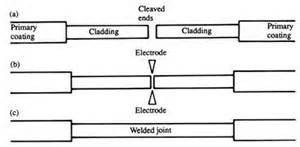Fusion Splicing FAQ, Updating
Fusion Splicing FAQ 1: What is Fiber Splicing?
A: Fiber Splicing is used to permanently join two optical fibers where no additional changes are expected to be made to those fibers at that juncture. This is in contrast to connectors, which are designed to allow quick re-configuration of fiber links. There are two ways to splice optical fibers: mechanical and fusion.
In a mechanical splice, the fibers are held together with ends touching inside some type of sleeve. Mechanical splices are typically used for semi-permanent connections, as in an emergency restoration or for testing and troubleshooting. Mechanical splices usually exhibit greater loss and reflection than fusion splices.
In fusion splicing, the two fibers are literally welded, or fused together. This makes for a strong joint that exhibits very low loss and virtually no reflection. This paper focuses on fusion splicing, although much of what is discussed here can also be applied to mechanical splicing.

Fusion Splicing FAQ 2: What is the fusion splicing?
A: Fusion splicing is performed with a piece of equipment called a fusion splicer. The fiber ends are prepared and cleaved, placed in alignment fixtures on the fusion splicer, and at the press of a button the fiber ends are heated with electrodes, brought together, and fused. There are many models of fusion splicers available, varying in features and capability, and of course cost. High-end units allow users to store separate programs or recipes where factors such as splice time and temperature can be highly customized. Such units magnify and visually display the splice, and use active core alignment to line up the fibers. Light injection technology and imaging software line up the cores so maximum light passes from one fiber to the other, ensuring minimal splice loss. Such splicing units can also provide an estimate of the splice loss. More basic fusion splicers may employ clad alignment to line up the fibers for splicing. The fibers sit in a holder or V-groove, and are lined up “physically”, based on the outer diameter.
Fusion Splicing FAQ 3: How to Monitor the Optical Fiber Splicing Quality?
A: For optical fiber cable splicing quality monitoring, at present in the engineering mainly have three kinds of monitoring methods,First, using the display screen of the welding machine to monitor Second, using OTDR to monitor the splicing point Third, using light source, optical power meter to weld loss to cut or insert test, but direct cut or insert belong to destructive testing, so it is not usually using in engineering.
Fusion Splicing FAQ 4: Why do I get “offset” errors on my fixed v-groove splicer?
A: Offsets are usually caused by debris on the v-grooves or on the fiber. FOWIKI.com recommends a splicer v-groove cleaning kit.
Fusion Splicing FAQ 5:: I get “Large Dust Burn” error messages when I am splicing. Is there something wrong with my splicer?
A: No. Large dust burns are contamination or excessive alcohol igniting during the splicing process. This is feedback to the operator to check his fiber preparation procedures. Multiple “Large Dust Burn” errors can lead to problems with arc power.
Fusion Splicing FAQ 6:: When I perform an arc calibration, I get the message “Power Inadequate”. Why does that happen?
A: It may take several iterations to get the arc power to its optimal value. Continue performing the arc calibration tests until it passes.
Fusion Splicing FAQ 7:: What is the difference between the sheath clamp and fiber holder?
A: The sheath clamp is a hinged magnetic clamp that is attached to the splicer. The fiber is placed in position and then clamped in place with the hinged mechanism. The sheath clamp can be removed on the single fiber splicers such as the FSM-70S and FSM-19S to allow the use of fiber holders. The fiber holders also have a hinged magnetic clamp, but are used for handling the fiber for the cleaving process. The fiber holder is then positioned in the splicer. Inexperienced persons have an easier time with fiber holders. All ribbon splicers require the use of fiber holders.